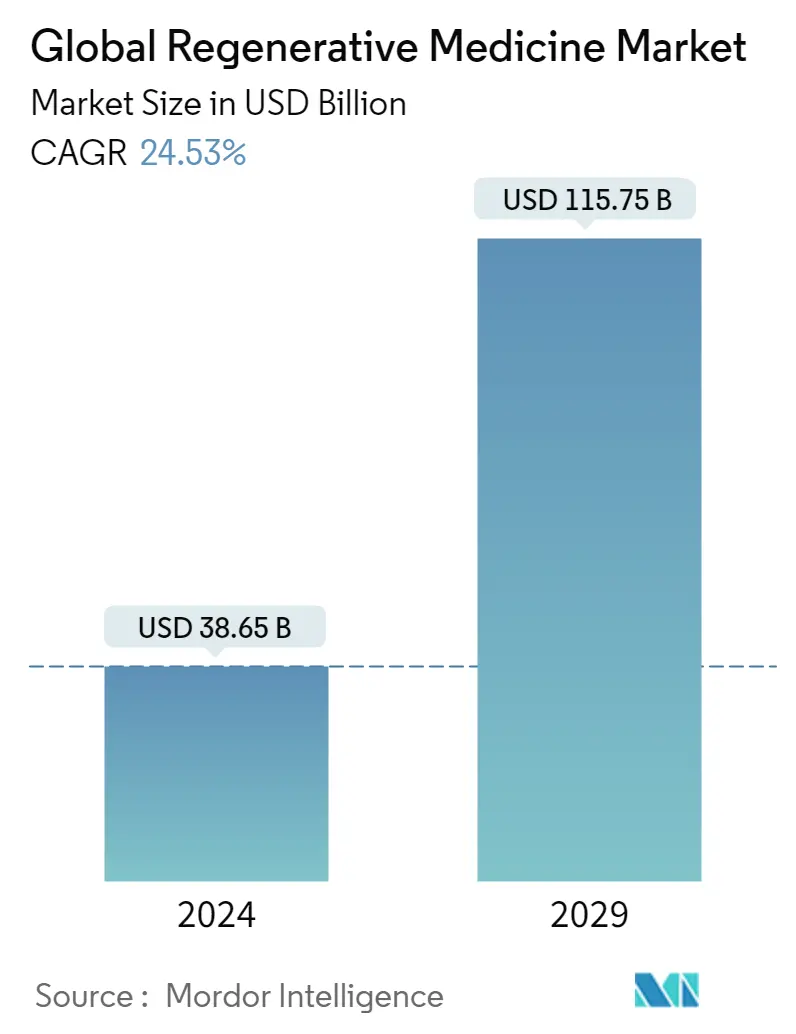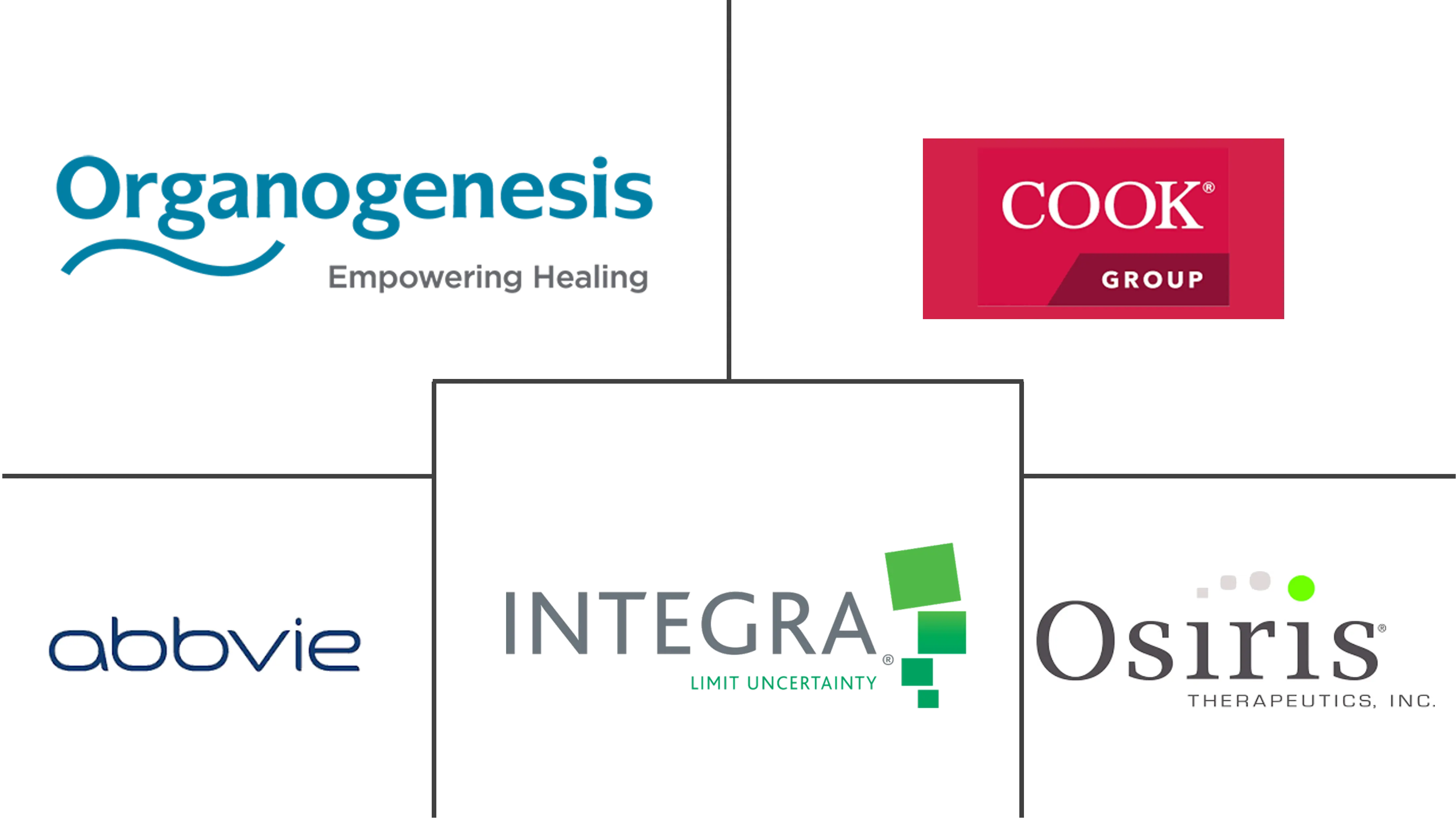Market Size of Global Regenerative Medicine Industry

| Study Period | 2019 - 2029 |
| Market Size (2024) | USD 38.65 Billion |
| Market Size (2029) | USD 115.75 Billion |
| CAGR (2024 - 2029) | 24.53 % |
| Fastest Growing Market | Asia Pacific |
| Largest Market | North America |
Major Players
*Disclaimer: Major Players sorted in no particular order |
Need a report that reflects how COVID-19 has impacted this market and its growth?
Regenerative Medicine Market Analysis
The Global Regenerative Medicine Market size is estimated at USD 38.65 billion in 2024, and is expected to reach USD 115.75 billion by 2029, growing at a CAGR of 24.53% during the forecast period (2024-2029).
The COVID-19 pandemic is expected to have a significant impact on the market. The rising COVID-19 cases across the world are having a profound positive impact on the market, as mesenchymal stem cells are a safe and effective approach to the treatment of COVID-19 according to a 2020 research article published in the scientific journal Aging and Disease titled, 'Mesenchymal Stem Cell Therapy for COVID-19: Present or Future'. More than 10 projects have been registered in the official international registry for clinical trials, in the beginning of 2020, implicating the use of stem cells to patients with coronavirus pneumonia. However, it is still at an initial stage of the study in relation to the market studied. In May 2020, the Global Institute of Stem Cell Therapy and Research (GIOSTAR) received approval for a COVID-19 clinical trial in using stem cells to treat COVID-19 patients. In May 2020, a patent was granted to the Ministry of Economy, the United Arab Emirates, for the development of innovative and promising stem cell therapy for the COVID-19 treatment. Thus, these developments in stem cell research for COVID-19 is expected to boost the demand for the market growth for regenerative medicines.
The key factors propelling the growth of the global regenerative medicine market are the increasing adoption of stem cell technologies, gene therapies, and tissue engineering, and the technological advancements in regenerative medicine. There has been a rising trend of government initiatives and clinical trials that are associated with stem cell research, which promote the growth of the regenerative medicine market. For instance, in February 2022, Indian Council of Medical Research (ICMR) has released the National Guidelines for Stem Cell Research (NGSCR) 2017 which were framed in harmonization of international guidelines. Government has supported the ethical and scientific conduct of stem cell research through guidelines for stem cell research. The Department of Biotechnology (DBT) has supported projects for basic biology of stem cells; early and late translational research; developing gene editing technology for potential therapeutic applications and creation of animal models for various human diseases. The funds released by the DBT during the last three years and the current year in this area is INR 7345.58 Lakh. The funding agreement may accelerate the company's rapidly scaling business of providing cutting-edge reagents and tools to support life science researchers around the world working in the regenerative medicine field. As per Australian Government Department of Health 2019, the stem cell therapies mission was launched by the government of Australia. It is a research funding program, with an investment of around USD 150 million, over 9 years, to develop innovative, safe, and effective treatments for the patients suffering from incurable diseases where regenerative medicines could be developed by using stem cells. The California Stem Cell Research, Treatments and Cures Initiative of 2020 also got the approval from the government in 2019. The initiative authorizes USD 5.5 billion in state general obligation bonds to fund stem cell research, therapy development, and therapy delivery in the region. In November 2020, the Government of Canada and The Juvenile Diabetes Research Foundation (JDRF) Canada announced a new research funding to accelerate stem cell-based therapies for Type-1 diabetes. This funding was provided by the Canadian Institutes of Health Research Institute of Nutrition, Metabolism and Diabetes (CIHR-INMD), and The Juvenile Diabetes Research Foundation Canada, and it was USD 3 million from each of the three organizations for over five years.
According to the clinical trial registry as of August 26th, 2022, there were 1,868 clinical trials of stem cell therapy, of which 82 studies were specifically targeted towards regenerative medicines across the world. This is likely to increase the demand for stem cell-based products and regenerative medicines in the market over the next few years. According to clinicaltrials.gov database, the majority of active recruiting trials are present in the United States, Europe, and China, with rising support from Canada, the Middle East, and Australia. Acute lymphoblastic leukemia (ALL), acute megakaryoblastic leukemia (AML), and acute graft versus host disease (AGHD) are some of the current indications that are primarily being focused upon by majority of the universities, research centers, and companies. Thus, it is evident that there are growing initiatives associated with stem cells and regenerative medicines, and it is estimated that over the forecast period, the success rate and further approval will rise gradually, which is primarily expected to drive the growth of the market.
